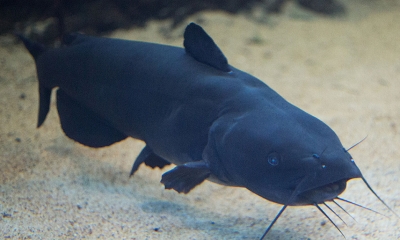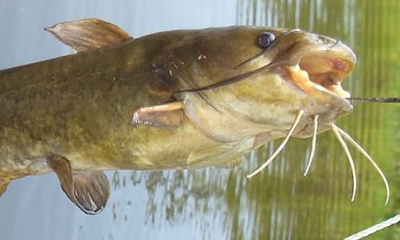
Catfish
Channel catfish are a prized species in many parts of the state. At the same time, illegally introduced bullhead catfish can disrupt other fisheries such as trout.

Types of Catfish

Features: Bullheads present in Oregon (brown, yellow and black) are distinguished from channel catfish by their square or rounded tails and lack of spotting. They seldom exceed two pounds and 18-inches long. Black bullheads have a square tail with a light vertical bar at its base and chin barbels that are all dark.
Habitat: Bullheads are found on the bottom in the shallows of mud-bottomed ponds, lakes, reservoirs and backwaters of rivers. The black bullhead is primarily in reservoirs and streams tributary to the Snake River. Bullheads feed on almost any type of plant or animal material; insect larvae and mollusks comprise much of their diet.
Technique: Bullheads can be caught any month of the year, but fishing is best from the first warm days of February through October. Bullheads feed most actively at night, utilizing the senses of touch and smell. Consequently the best angling for them is in the evening or at night under a lantern. Look for them where there is shallow water with a mud bottom. Use a bottom slip-sinker and bait rig with size 6 or 8 hook baited with worms or chicken livers. In shallow water, a bobber and bait rig may also be used with the bait on or near the bottom. When handling bullheads be careful to avoid the spines in the fins. When properly skinned and cooked, bullheads are fine eating.

Features: Bullheads found in Oregon are distinguished from channel catfish by their square or rounded tails and lack of spotting. They seldom exceed two pounds and 18-inches long. Brown bullheads are a mottled yellowish-brown with a yellow belly and dark chin “whiskers” or barbels that are white near the base. They have a square tail.
Habitat: Bullheads are found on the bottom in the shallows of mud-bottomed ponds, lakes, reservoirs and backwaters of rivers. The brown species is common throughout the state.
Technique: Bullheads can be caught any month of the year, but fishing is best from the first warm days of February through October. Bullheads feed most actively at night, utilizing the senses of touch and smell. Consequently the best fishing for them is in the evening or at night under a lantern. Look for them where there is shallow water with a mud bottom. Use a bottom slip-sinker and bait rig with size 6 or 8 hook baited with worms or chicken livers. In shallow water, a bobber and bait rig may also be used with the bait on or near the bottom. When handling bullheads be careful to avoid the spines in the fins. When properly skinned and cooked, bullheads are fine eating.
Header image by Richard Clinton
Features: Channel catfish are pale bluish-olive above and bluish-white below with a deeply forked tail, dorsal and pectoral spines, and an adipose fin. Like all other catfish, channel catfish have “whiskers” or barbels extending from the chin and upper jaw. Young fish have a varying number of small black spots over much of the body, while older fish may be partially or entirely without spots. Maximum size in Oregon approaches 40 pounds, but most are less than 10 pounds.
Habitat: Channel catfish in western Oregon are limited to the Columbia River, lower Willamette River, and a few ponds in the Willamette Valley. They are much more abundant in eastern Oregon, primarily in the Columbia and Snake rivers and their impoundments, Owyhee Reservoir, the Owyhee River, and the John Day River. When given the choice, channel catfish prefer clear lakes and streams, but they can tolerate moderately muddy water if food is abundant. Channel catfish are not particular about what they eat. Included in their diet are fish and frogs, either alive or dead, insects, plant material, crayfish, worms, or snails.
Technique: Channel catfish are found near cover such as debris, logs, cavities, boulders and cut banks in the warmest parts of lakes and rivers. They seek cavities near shore, usually in 6 to 12 feet of water, in which to spawn when the water temperature reaches 70°F. In rivers, adult channel catfish are found in the larger pools and deeper holes.
Channel catfish are most active in late evening, but feed during the daylight hours more than other catfish species. Although usually caught on bait, they will occasionally take a lure. Fish on the bottom using a slip-sinker and bait rig with size 4 or 6 bait hook. Bait with worms, strips of fish belly, liver, or a commercially prepared “stink” bait. When handling catfish be careful to avoid the spines in the fins. Channel catfish are excellent eating, the flesh being white, firm, and relatively boneless.

Features: Bullheads present in Oregon are distinguished from channel catfish by their square or rounded tails and lack of spotting. They seldom exceed 18 inches in length and a weight of 2 pounds. Yellow bullheads are a more uniform yellow color with white or cream chin barbels and a rounded tail.
Habitat: Bullheads are found on the bottom in the shallows of mud-bottomed ponds, lakes, reservoirs and backwaters of rivers. The yellow bullhead is found mainly in the Willamette basin.
Technique: Bullheads can be caught any month of the year, but fishing is best from the first warm days of February through October. Bullheads feed most actively at night, utilizing the senses of touch and smell. Consequently the best angling for them is in the evening or at night under a lantern. Look for them where there is shallow water with a mud bottom. Use a bottom slip-sinker and bait rig with size 6 or 8 hook baited with worms or chicken livers. In shallow water, a bobber and bait rig may also be used with the bait on or near the bottom. When handling bullheads be careful to avoid the spines in the fins. When properly skinned and cooked, bullheads are fine eating.

